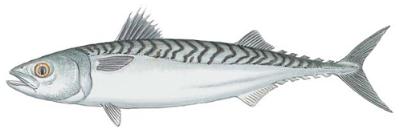Like other members of the Scombridae family, the Atlantic mackerel is a fast-swimming, schooling, pelagic species that garners significant recreational and commercial interest. Sometimes it is almost completely absent, and at other times it is plentiful in swarming schools.
Identification
The Atlantic mackerel has a smooth, tapering head, a streamlined body, and brilliant coloration. An iridescent greenish-blue covers most of the upper body, turning to blue-black on the head and silvery white on the belly. The skin is satiny and has small, smooth scales.The tail is forked. A distinguishing characteristic is the series of 23 to 33 wavy, dark bands on the upper part of the body. There are two fins on the back, one spiny and one soft, followed by a number of small finlets. There are also finlets on the undersurface of the body near the tail.
 |  |
Size/Age
The average size for adults is 14 to 18 inches and 1.25 to 2.5 pounds. The all-tackle world record is a 2-pound, 10-ounce Norwegian fish. The maximum age is roughly 20 years.Life history/Behavior
Atlantic mackerel native to the western Atlantic comprise two populations. The southern population appears offshore in early April, advancing toward Virginia, Maryland, and New Jersey to later spawn off New Jersey and Long Island. In late May, the northern group enters southern New England waters for a short period and mingles with the southern stock, then moves north to spawn off Nova Scotia in the Gulf of St. Lawrence in June and July.Atlantic mackerel are moderately prolific. The eggs are released wherever the fish happen to be, leaving adverse winds to push eggs or small fry into areas where their chances of survival are slight. This behavior, combined with predation of large, as well as young, mackerel, results in a curious pattern of either superabundance or scarcity.
